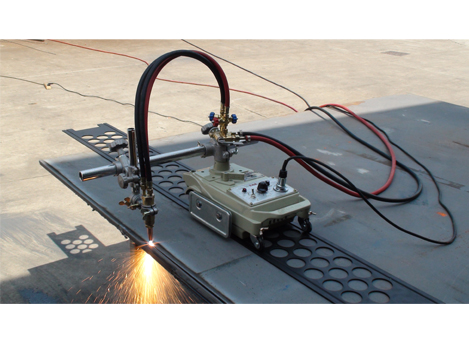Gas cutting is done by preheating a spot on ferrous metal to its ignition temperature and then burning it with a stream of oxygen in the manner.The necessary temperature is maintained by means of gas flames obtained from the combustion of a fuel gas and oxygen. The commonly used fuel gases are acetylene (C2H2), hydrogen, natural gas, which is largely methane or CH4, propane (C3H8), or butane (C4H10);. The most popular is acetylene.
Principle of Gas cutting
Gas cutting is the use of combustible gas and oxygen mixed combustion flame heat heat will be preheated to a certain temperature of the workpiece cutting, jet out of high-speed cutting oxygen flow, so that the metal intense oxidation and heat release. The method of cutting is achieved by blowing off molten metal oxides by means of cutting oxygen flow.
Advantages of Gas Cutting Machine
Gas Cutting Machine is made of high strength alloy aluminumby die-casting.
Worm wheel and worm is Gear-box is made of special material,bear wear and tear.The speed system is adjusted by feeler of controlling silicon unit, easy operating;
Oxygen acetylene hoses imported from abroad;
Quick switch for hose assembly, easy operating;
Suitable for ship building,oil, chemical,and metal structure factory, etc;

Process
Thermal cutting using flame separation materials produced by combusting combustible gas with oxygen, also known as oxygen cutting or flame cutting. During gas cutting, the flame preheats the material to the ignition point at the starting point, and then sprays an oxygen flow to violently oxidize and burn the metal material, and the generated oxide slag is blown away by the air flow to form a cut.
Gas cutting process
The generation of heat by combustion of acetylene and oxygen is used to bring the base metal up to its kindling temperature, where it will ignite and bum in an atmosphere of pure oxygen. The stream of oxygen also assists in removing the material from the cut. Oxygen for cutting must be 99% pure.If purity is less, cutting speed and efficiency will be reduced.
Before you begin cutting, take the time to clean your metal. Paint, dirt, rust, and other contaminants will interfere with the cut. Paint can be burned with the torch and brushed off. Protect yourself from the toxic fumes if you decide to do this. When possible, clean both sides of the metal. Contaminants on the backside can stop the cut from going all the way through the metal. If only one side is slightly rusty, make the cut with the rusty side facing down and the clean side up.
Application
The metal material to be gas cut shall meet the following conditions:
①In pure oxygen can be violent combustion, its ignition point and slag melting point must be lower than the melting point of the material itself. Slag has good fluidity and is easy to be blown away by airflow.
②Small thermal conductivity. In the cutting process, the oxidation reaction can generate enough heat to make the preheating speed of the cutting site exceed the thermal conductivity of the material, so as to keep the temperature in front of the incision always higher than the ignition point, so that the cutting will not be interrupted.
Whether you are using acetylene or propane for your fuel gas, gas cutting is limited to carbon steel. All other metals can’t be cut, but can be melted with a torch. Steel is unique in that the melting point of the oxidized metal is lower than that of the base metal, allowing the cutting action to take place. With all other metals, such as stainless steel, brass, and aluminum, the oxidized metal created has a higher melting point than the base metal, preventing the torch from making a cut. Fortunately, carbon steel is the most common material used in metal working, so torches come in handy on a regular basis.
Gas cutting can be made in the horizontal, vertical, and overhead positions on sheet, plate, and structural shapes such as pipe. When making vertical cuts, try traveling downhill on thinner metals and uphill on thicker metals. It is used for flame gouging, to remove weld defects, and for edge preparation.






